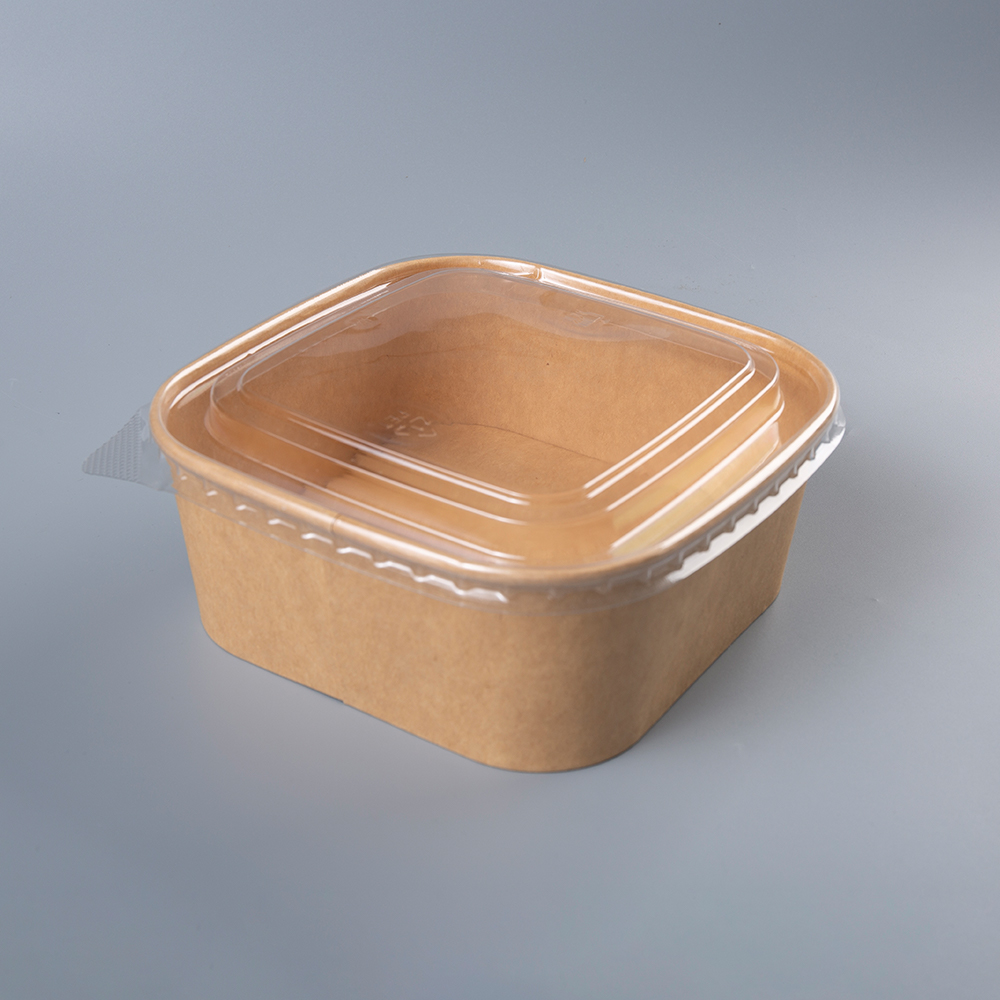In the process of producing paper salad bowls, controlling the appearance and structural quality is the key link to ensure that the product meets food safety standards, user experience and brand image. In order to ensure the quality of paper salad bowls, manufacturers need to carry out fine quality control from multiple aspects.
The production of paper salad bowls depends on the quality of paper, so material selection is crucial. First of all, the paper should meet food-grade safety standards and contain no harmful chemicals. The material needs to undergo rigorous testing to ensure that its strength, toughness and waterproofness meet the requirements. Food-grade paper generally requires FDA certification (US Food and Drug Administration), EU regulatory certification, etc. to ensure that the paper material is safe when in contact with food.
Establish a stable cooperative relationship with suppliers to ensure the stability and consistency of materials. Regularly sample and inspect paper raw materials to ensure that each batch of raw materials meets production standards.
In order to enhance the waterproof and oil-resistant properties of paper bowls, paper is usually coated. The coating material must be selected from materials that are harmless to food safety, such as water-based coatings or natural coatings. The coating process needs to control the uniformity of the coating to ensure that the coating thickness of each sheet of paper is consistent. The quality control of the coating can be completed through online detection and sampling tests.
The molding process of paper salad bowls is generally through mold pressing. The precision of the mold is crucial to the appearance and structure of the paper bowl. The mold surface must be kept smooth to avoid scratches or defects during the molding process. In addition, the pressing pressure needs to be uniform. Too much or too little pressure will cause the paper bowl to deform or uneven quality.
During the production process, the size and shape of the paper bowl need to be strictly controlled to ensure that the diameter, height and other dimensions of each paper bowl meet the design specifications. Excessive size deviation will affect the stability of the paper bowl and the practicality of the container. The production process can be monitored in real time by an automated visual inspection system to detect the size error of the paper bowl and automatically correct it.
Wrinkles, wrinkles, bubbles, scratches and other defects may appear on the surface of the paper bowl, which will affect the appearance of the paper bowl and the consumer's experience. During the production process, the curling degree of the paper, the uniformity of the coating and the pressure of the mold need to be strictly controlled. Regular manual or automated quality inspections are carried out to detect and remove defective products in a timely manner.

If there is a printed pattern on the paper bowl, the color consistency, pattern clarity and position of the printing need to be controlled. The printing ink must use materials that meet food safety requirements and ensure that the ink does not fall off. The production line needs to be equipped with precision equipment such as colorimeter to ensure that the pattern and color of each paper bowl are consistent.
The structural strength of the paper bowl needs to ensure that it is not easy to break or deform during use. In order to ensure that the paper bowl can bear the weight of salad and other foods, compression and bending tests can be carried out. Common testing methods include pressing the paper bowl with a standard weight object and observing its deformation; or placing the paper bowl under a specific external force to check its load-bearing capacity.
Paper salad bowls need to have a certain degree of water resistance, especially when used to hold salads with more oil and juice. During the production process, the water resistance of paper bowls must be tested. Common testing methods include placing the paper bowl in liquid and observing whether its surface is penetrated or leaking. If necessary, a long-term bubble test can also be carried out to ensure that the paper bowl is not penetrated by liquid for a period of time.
The material of the paper salad bowl should be able to be used in a certain range of temperatures, especially when holding hot or cold food. The temperature resistance of the paper bowl needs to be tested during production to ensure that it will not deform or break at higher or lower temperatures.
High-precision visual inspection systems are used to perform real-time inspections on each paper bowl on the production line. These systems can detect issues such as size, appearance defects, coating uniformity, and printing quality, thereby automatically sorting and removing defective products. This automated inspection method not only improves production efficiency, but also reduces human errors.
Some paper bowl production lines are equipped with online weight detection systems to ensure that the weight of each paper bowl is within the specified range. Too light weight may mean that the paper bowl is not strong enough, while too heavy weight may mean that too much paper is used, increasing production costs.
Controlling the appearance and structural quality of paper salad bowls requires refined management throughout the production process. This not only helps to improve the market competitiveness of products, but also enhances consumers' user experience and brand reputation.













 English
English 中文简体
中文简体 عربى
عربى

